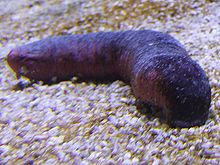About a year ago, on October 15th 2009 to be precise, I wrote a brief post about a Phase II trial in which an extract from sea cucumbers, rather bizarre-looking creatures (see photo), was being tested on smoldering myeloma patients: http://margaret.healthblogs.org/2009/10/15/sea-cucumbers-and-smoldering-myeloma/ At the time, not much information was available…
creatures (see photo), was being tested on smoldering myeloma patients: http://margaret.healthblogs.org/2009/10/15/sea-cucumbers-and-smoldering-myeloma/ At the time, not much information was available…
(A quick aside: this morning, after glancing at my 2009 post, I discovered that the main sea cucumber study link now leads to a blank page instead of an abstract. Uffa. Well, that may happen from time to time with some of my outdated links, since I cannot possibly check them all… At any rate, no worries, I went to the Clinical Trial website where I found another link…)
Anyway, why am I mentioning sea cucumbers today? This morning a friend (thanks!) sent me an ASH (American Society of Hematology) 2010 meeting abstract concerning this sea cucumber extract/smoldering myeloma trial. So now we have a bit more information: http://goo.gl/SbmJ2
The authors are wary both of chemoprevention trials for SMM folks (No kidding!!! Ma scherziamo???!!!) and what they call “bioactive food supplements”: curcumin, resveratrol and EGCG. Concerning the supplements, they say that many patients are taking them without definitive proof of efficacy or safety (my emphasis).
Now, as for “efficacy,” I actually agree with the authors, since I haven’t been taking curcumin for a long enough period to establish its efficacy in the long term, and I don’t know anyone who has been taking curcumin longer than I have. So, for now at least, we will have to set that one aside…and wait 10, 15 or more years…
As for “safety,” well, I certainly would agree that supplements taken in high doses are not safe. It boils down to common sense. Remember that study concerning a once-a-year, ridiculously high vitamin D dose? Exactly…
But curcumin is different. With curcumin, we have guidelines. Doses of up to 12 grams/day have been tested on healthy folks with minor side effects (mild nausea, diarrhea at the worst). The drawback to these types of studies is that, as far as I know, they have not lasted for more than a few months, undoubtedly because they cost not an arm and a leg but many arms and legs (and who would finance a study like that? Not big pharma, for sure!)…
So I can only offer my own case as an example: as many of you know, I have been taking 8 grams of curcumin for almost 5 years now…and, in addition to the stability of my MM markers (up a little, down a little = what I have named “the seesaw effect”…), I have experienced only positive side effects, such as protection from the very unpleasant and recurrent infections to which I used to succumb to in the pre-curcumin period…
But let’s get back to these interesting sea cucumber critters, which contain sphingolipids/glycosides that […] have also demonstrated antitumor properties including antiangiogenesis direct tumor cytotoxicity, and also of particular relevance to MM, the inhibition of osteoclastogenesis. Aha! Good stuff!
The extract being tested in this Phase II trial is called TBL 12, which has been commercially available since 1981 and used by human subjects as a food supplement without any reported toxicities. Ah. I actually didn’t know that…
Anyway, the SMM patients took two units of 20 ml of this extract twice a day, which adds up to 40+40=80 units a day. By the way, based on the Mayo classification, most of these patients (13 out of 20) were high-risk, like yours truly: serum M-spike of at least 3 g/dL and at least 10% plasma cells in their bone marrow. Anyway, you can read more details about the patients in “Results.”
An important excerpt: the treatment was well tolerated with only grade 1 nausea. Excellent…
The abstract also tells us that the best response so far has been stable disease. Not bad, not bad. I am all in favour of “stable” until something else more promising, non-toxic blablablathingy, comes along. Oh, but wait…there is more. In one case, The decrease in the rate of rise in the m-spike in a high risk patient concomitant with the initiation of study treatment is suggestive of a biologic effect of TBL12 in MM and warrants further study of TBL 12 in a larger cohort of patients. You can see his/her M-spike graph in the abstract. Well, well, well…
Sounds good to me…!!!
your sea cucumber picture makes one really hungry for the extract!
Thanks for the high lights of the study! I have been such a lazy cow lately ( just normal considering where I live!)